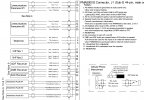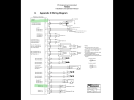Go to the PS Engineering web site and download the current installation guide.
It has two different diagrams, for four place and six place versions. Since the diagram you posted doesn't have the same text at the top indicating which part number the diagram applies to, I suspect you don't have a current manual. Either that or PS Engineering simply opted to send you a single diagram with your intercom.
This is from the 4-place intercom diagram, except I shrunk it a bit to make it fit better here;
View attachment 5288
Pins 14, 12 and 25 are for an auxiliary jack that can bypass the intercom. Although those pins do connect to the intercom, they also go directly to the radio. It's purpose is to allow direct use of the radio when the intercom fails, or to bypass the intercom for troubleshooting. It can operate your radio even with the connector completely removed from the intercom. So if you have that jack installed (not everyone uses it), it might help in isolating your problem here. Some people who install this jack don't actually put it on the panel. They just leave it hanging on the wiring harness behind or under the panel so it doesn't take up panel space. If you weren't the original installer, it's possible there's an auxiliary jack hiding somewhere.
You can use a music input for alert audio from the HDX if you want to, but your intercom has an automatic mute function on those inputs. Your alert audio will be muted anytime the radio is sending or receiving a transmission, whether the transmission is directed at you or not. Essentially. whenever anyone keys a mic on the radio frequency you're tuned in to, your alert audio gets turned off. You'll still see alerts on the screen, but you won't hear them. The PM3000 does allow you to disable the mute function by pressing the squelch button in (karaoke mode), but that may be a 'soft key' you'd have to activate every time you turn the intercom on. Again, this is user choice, and some people don't care if their alert audio mutes. But when you have unswitched connections available to prevent that from happening (you have two unswitched inputs), I don't see why you wouldn't use them.
And since we're on that topic, when you say you're 'getting squelch' when you pull the knob out, do you mean you're getting radio static when you pull it out or push it in? If so, I don't think it's radio static. The squelch functions by rotating the knob. According to what I see in the user manual, pushing it in simply enables or disables the mute function for the music input. That would mean your static is coming from your music inputs, not your radio. You can simply disconnect the music (entertainment) inputs on the intercom, pins 24, 11, and 18, to confirm this.
PS: I've edited this post a couple of times, so make sure you didn't miss something I may have put in after you initially read it.


